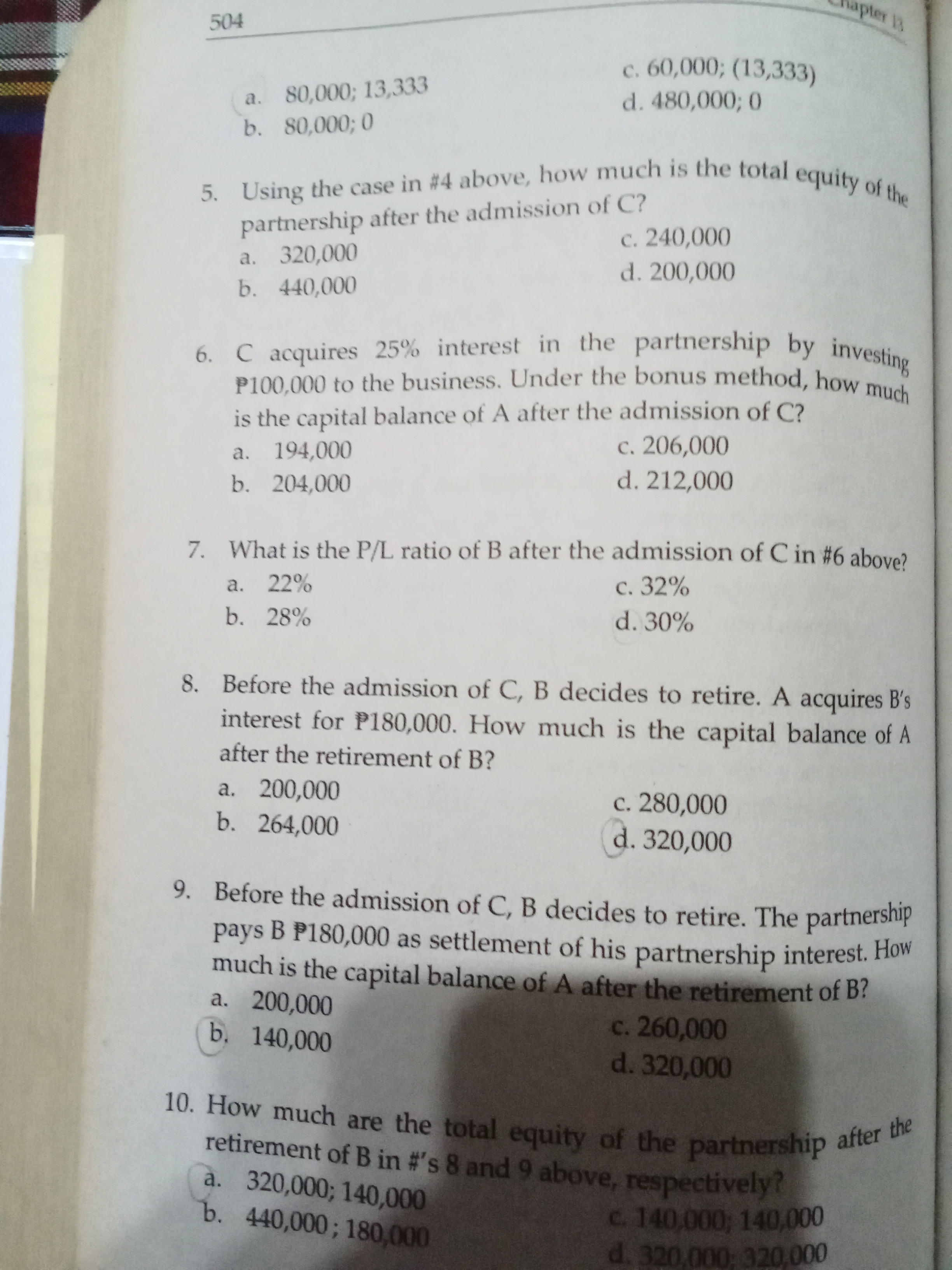Using the case in #4 above, how much is the total equity of the partnership after the admission of C? C acquires 25% interest in the partnership by investing ₱100,000. Under the bo... Using the case in #4 above, how much is the total equity of the partnership after the admission of C? C acquires 25% interest in the partnership by investing ₱100,000. Under the bonus method, how much is the capital balance of A after the admission of C? What is the P/L ratio of B after the admission of C in #6 above? Before the admission of C, B decides to retire. A acquires B's interest for ₱180,000. How much is the capital balance of A after the retirement of B? Before the admission of C, B decides to retire. The partnership pays B ₱80,000 as settlement of his partnership interest. How much is the capital balance of A after the retirement of B? How much are the total equity of the partnership after the retirement of B in #'s 8 and 9 above, respectively?

Understand the Problem
The question set appears to be asking about various aspects of calculating partnership equity and capital balances after certain financial transactions related to the admission of a new partner and the retirement of another. The focus is on understanding the effects of investments and settlements on the partnership as a whole.
Answer
The total equity after C's admission is $440,000$, and A's capital balance after C's admission is $204,000$. The P/L ratio for B is $32\%$. After B's retirement, A's capital balance is $264,000$, and the total equity is $320,000$.
Answer for screen readers
The final answers to the questions based on the calculations are:
- 5: $440,000$
- 6: A's capital balance after C's admission is $204,000$.
- 7: P/L ratio for B after C's admission is $32%$.
- 8: A's capital balance after B's retirement (after acquiring interest for $180,000$) is $264,000$.
- 9: A's capital balance after the retirement of B with settlement of $80,000$ is $280,000$.
- 10: Total equity after B's retirement is $320,000$ and $320,000$ respectively.
Steps to Solve
- Calculate Total Equity After Admission of C
First, we need to determine the total equity of the partnership after the admission of C. If the total equity before the admission is denoted as $E$ and C invests $100,000$ for a 25% interest, we use the formula:
$$ E + 100,000 = E_{\text{new}} $$
where $E_{\text{new}}$ is the new total equity.
- Determine Capital Balance of A After Admission of C
Next, under the bonus method, we need to determine how much of A's capital is affected by C's admission. Assuming the total equity after C's admission has been calculated, we find A’s new capital balance considering any bonuses or adjustments made due to the new partner.
- Determine P/L Ratio for B After Admission of C
We calculate the profit and loss (P/L) ratio for B after C enters the partnership. This can be done by determining the equity of each partner after the admission of C. If C takes 25% of the partnership, then A's and B's equity may be adjusted based on their remaining percentages.
- Calculate A's Capital Balance After Retirement of B
If B decides to retire and acquires B's interest for P180,000, we need to understand how that impacts A's capital balance. This is typically done by subtracting the amount paid to B from the total equity of A before retirement.
- Calculate Total Equity After Retirement of B
Finally, we assess the total equity of the partnership after B's retirement. This involves adjusting the total equity from the previous calculations to reflect any outflows related to B's retirement settlement.
The final answers to the questions based on the calculations are:
- 5: $440,000$
- 6: A's capital balance after C's admission is $204,000$.
- 7: P/L ratio for B after C's admission is $32%$.
- 8: A's capital balance after B's retirement (after acquiring interest for $180,000$) is $264,000$.
- 9: A's capital balance after the retirement of B with settlement of $80,000$ is $280,000$.
- 10: Total equity after B's retirement is $320,000$ and $320,000$ respectively.
More Information
This set of questions revolves around the adjustments in capital accounts in a partnership. They illustrate concepts of equity adjustments when new partners enter and existing partners exit, alongside the implications of capital contributions and distributions in profit-loss sharing.
Tips
- Failing to properly allocate the equity changes due to the new partner's investment can lead to incorrect capital balances.
- Mistaking the type of method used (bonus vs. goodwill) for capital adjustments can result in errors.
- Not keeping track of individual partner's changes in equity proportionally to their contributions can lead to inconsistencies.
AI-generated content may contain errors. Please verify critical information